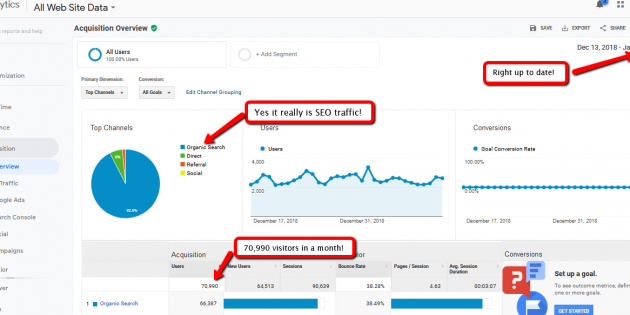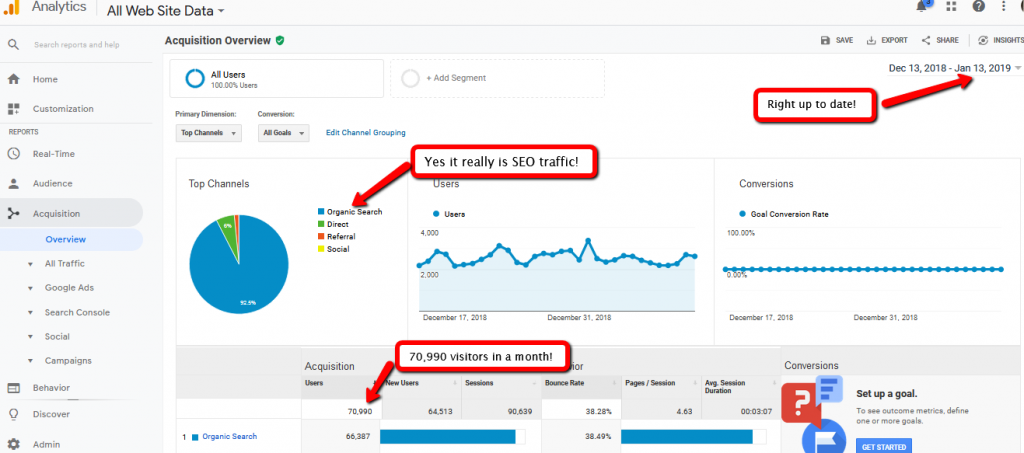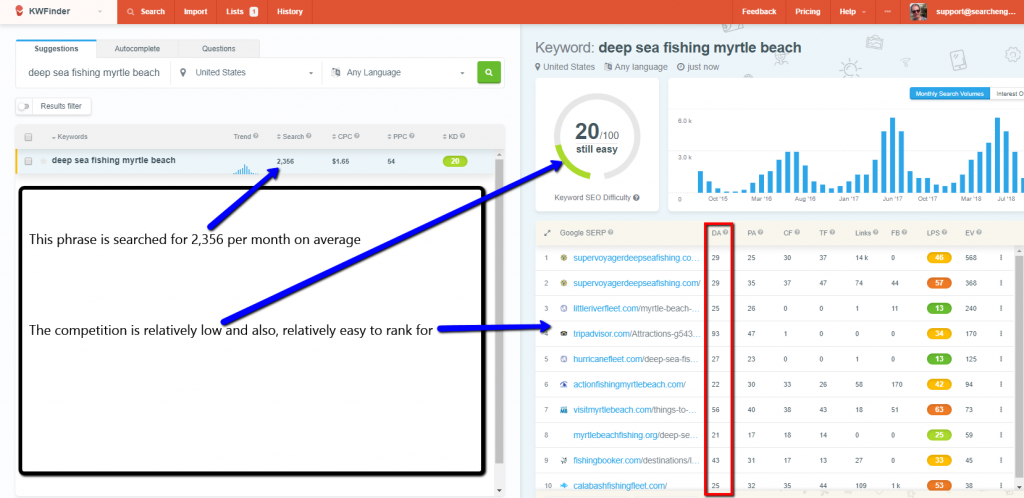Getting over 70,000 visitors per month consistently is very impressive, and many people that are optimizing their site might think that stats like this are unachievable unless you are an authority site. I am here to tell you that you don’t need to have an authority site to get this kind of traffic.
The client site with the analytics shown above has asked me not to reveal the identity of their site, but they have given permission to show the results. I initially built this clients website about 2 or 3 years ago roughly, so we are really only talking about a young site. However, as you can see from the analytics screenshot, more than 80% of the visitors are organic. These visitors are coming from Google search and are highly targeted. I can tell you now, that this website makes towards $1,000,000 per year. That’s 2 million dollars! My client is extremely happy with these results.
How Did I Do It?
So, how did I do it? What did I do that enabled this site to get so much traffic from Google and make so much money? Let me explain…..
There is no one single thing that made the difference, but rather, a number of easy to do things that I implemented. Each of which, if I had left off, would mean this site would not be ranking where it is now.
The Domain
It might sound obvious, but I had to start with a domain. I had two options: -
- A Brand New Domain
- An Aged Domain That Had Some Authority
Most people when they want to build a website think of a name and if that name is available, they buy it and build their site. I didn’t do that. I purchased an aged domain that had a level of authority. The authority was nothing amazing (Domain Authority DA21), but that is vastly superior to a brand new domain. The aged domain had a ready done established SEO campaign which meant the site had a nice boost the moment the completed site was indexed.
The Content
I optimized the meta titles and tags on each page and post to the main key phrases of each page and the content was extremely relevant and so focused that it was a detailed information all about the a very narrow, focused subject. This was key to the ranking of the various pages, and from a content point of view, was the most important reason why this site has achieved such great success.
It is essential to make the niche of each page as narrow as possible. You need to drill down in to the overall wide niche of the total site. What I mean by this is if you have a site on fishing and your home page is just about fishing in general. Your site is never going to rank anywhere. The reason for that is because the subject is too broad, and search phrases like “fishing” are reserved for the ultra-powerful authority sites.
So back to this site, I took the sites main niche and drilled down so deep and created pages and posts that were so detailed on a tiny sector of a sub sub niche of the site. Here is an example of what I mean. Take fishing again. So you won’t rank for the keyword fishing. However, it would be relatively simple to rank for a phrase like:
“deep sea fishing myrtle beach”
This phrase has decent traffic for a long tail search and the competition is very low. Have a look at the keyword data below:
From a content perspective, all you need to do is create posts that are ultra laser targeted and theme those posts throughout your site.
Inner Linking
When you have your posts in place, it is important to strategically place inner links on each post that point to other posts on your site. Inner linking does three things: -
- It helps the visitor navigate around your site
- It helps increase your CTR and decrease your bounce rate which is a ranking factor from Google.
- It distributes link juice throughout your site to the pages & posts that are linked to which in turn is equivalent to carrying out a huge number of SEO campaigns to those pages. This has a huge effect on the visibility of the site overall
Backlinks
If you don’t have any inner links on your pages, any backlinks that come to a page will only affect the rank for that specific page. However, if you optimize your innerlinking, any backlinks you get to any page affects the rank of multiple pages on the site, which means your backlinks are leveraged which means that your sites visibility in the search engine will increase and more people will visit your site. The more people that visit your site will also help your rank if those people are remaining on your site and navigating around it. This makes your need for backlinks very apparent.
The backlinks I went after for this site were links from other sites in the same niche. Also, those sites needed to have a decent level of authority. The page authority really needed to be a minimum of PA30 or I wasn’t interested. The only times that would differ would be if the domain authority was DA40 or higher and I would use that post that linked to the client site as a tier 1 super post that I would link other posts to that had high page authority. By doing this, it meant that the super post would pass on a lot of the link juice from the other posts directly to my client page.
The reason for doing this link structure as opposed to pointing all links to the client page was that I wanted to have fewer backlinks that had impressive page authority as opposed to more backlinks that had a lower average page authority.
Conclusion
This is the basic strategy that I used to rank this client site. This strategy will work for any niche and it will work for you too.
The good news is that you don't need to do anything in so large a market as we did for that client...
... and you can still make an ongoing six figure income with only 7 clients!
Why so simple? because:
- Local SEO is the easiest (lowest competition) SEO you can do. I mean, it’s like the most straight forward SEO there is.
- The tools and know how to do this are becoming sophisticated as the internet develops.
...making it easy for you to do this and take your stake in the new gold rush.
Learn our Secrets? Exclusive Teaching Webinar
Well, can you really automate SEO?
The answer is – yes and no.
If you look at how SEO is done by those very few people who still know how to and rank at will in 2019...
…you’ll find their processes are slow, expensive, time-consuming.
What about if there was an alternative?
Well, there is an alternative! It’s called Turn-Key SEO.
The idea is – you just turn the key. Each part of the process (at least the repetitive, hard, time consuming work), is automated.
Making it connect-the-dots simple.
We are spilling the beans on our upcoming webinars - times at the link here. Join us!
Register right here: https://go.seo-breakthrough.com/seo-breakthrough-workshop
Don't miss it!
All the best,
John Pearce and Chris Cantell


